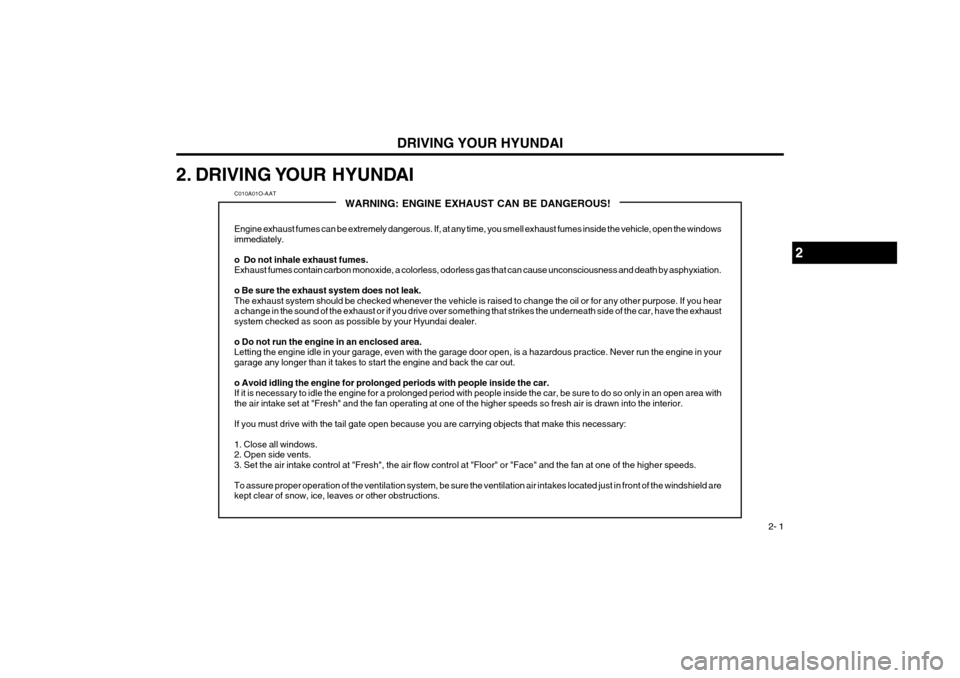Hyundai Coupe 2004 Owners Manual
Manufacturer: HYUNDAI, Model Year: 2004, Model line: Coupe, Model: Hyundai Coupe 2004Pages: 389, PDF Size: 10.22 MB
Page 91 of 389

FEATURES OF YOUR HYUNDAI 1- 83
5. FM, AM station search Turn the right rotary control to the left/right in desired waveband. The radio searches in de-scending/ascending order.
6. Scan search In the desired waveband (FM or AM) press the right rotary control, SC is displayed. An auto-matic station search is started. The first search isperformed on an insensitive plane, all furthersearches on a sensitive plane. Receivable sta-tions can be heard for 8 seconds. Press the rightrotary control if the received program should beretained.
7. Direct frequency input Select radio menu mode and then, within 8 sec- onds, enter the frequency using the multifunctionbuttons. 8. FM /AM station - retrieve/store Store: 10 frequencies or programs can be stored respectively on each of wavebands FM 1, FM 2and AM.Press multifunction button for 2 - 4 seconds inorder to store the desired station or program. Retrieve: press multifunction button "1-0". The stored station is requested.The frequency is displayed if the station cannotbe identified.
9.AM / FM autostore Select desired wave band. Select radio menu mode by pressing
button. Then Press multi-
function button "AS" repeatedly until AS-SEEK is displayed. The 10 stations with the best recep-tion are stored under the station buttons in orderof quality. The auto store plane is identified on thedisplay by AS. Select radio menu mode in orderto quit the autostore storage plane. Then pressmultifunction button "AS". The radio switchesback to the station button plane. 10.Manual tuning Select radio menu and the turn the right rotary control.Turning steps of 100 kHz (FM) or 9 kHz (AM) areperformer.Pressing the right rotary control switches to finetuning (1 kHz steps) for AM. The function is quitif there is no further actuation within 10 seconds.
B260B04GK
B260E01GK-GAT CD OPERATION 1.CDs - insert / eject Press
button briefly; the display folds down-
wards and the CD slot with the printed side upwards. The unit pulls in the CD automaticallyand begins to play the disc from the first track.Then fold the display up again. After playing thelast track, the unit automatically begins to playthe first track of the CD again. If there is alreadya CD in the CD slot, press
button repeatedly
until CD appears on the display. In order to eject a CD, press
button briefly; the display folds
downward and the CD is ejected. Then remove the CD. Then fold the display up again. NOTE: The CD is not ejected when the unit is switchedoff but remains in the CD slot.
2. Track skip - forwards / reverse Turn right rotary control to right/left. If the track has been playing for longer than 10seconds when the return function is triggered, areturn to the beginning of the track takes place.Through further turning of the right rotary control,several tracks can be skipped over in forward orreverse directions. Skip returns to the first to thelast track.
Page 92 of 389

FEATURES OF YOUR HYUNDAI
1- 84
3. Scan search Press and hold the right rotary control, until the prompt "SC" (5) appears on the display. Allfollowing CD tracks are played for 8 secondseach. Press the rotary control again to terminatethe search.
4. Fast forward /rewind Fast forward (audible) is activated by pressing the multifunction button (3) " " and fast rewind(audible) is activated by pressing the multifunc-tion button (2) " ". The relative time is displayedduring this function.
5. Relative time, number of tracks, to- tal playing time By pressing the multifunction button (1) "T", the relative time for the track currently being playedis displayed for approx.10seconds.
B260B05GK
(2) (3) (5)(1)(4)
By against pressing the multifunction button "T" (within 10 seconds), the number of tracks andtotal playing time of the CD currently being playedare displayed for approx.10 seconds
6. Random play The random play is activated by pressing the multifunction button (4) "RP". The tracks of thecurrent CD are then played in random order."RP" appears on the display. The random playfunction is terminated by repeated pressing ofthe multifunction button "RP".
7. Direct track selection The unit is switched to select mode by pressing the multifunction button "0" The digits 1-0 andTRACK _ _ are displayed. A track can be se-lected directly by using the multifunction buttons"1-0". The unit switches back to CD menu modeif no buttons are actuated for approx.8seconds.
8. Temperature protection circuit A temperature protection circuit is utilized in this unit in order to protect the laser diode againstover heating.When this protection circuit is activated, CDTEMP. appears for 8 seconds. The unit switchesback to the last selected signal source (FM / AM).The single CD operation can be requested againafter a short cooling phase. However, if thetemperature is still too high, the unit again switchesback to the previously selected signal source.
Page 93 of 389

FEATURES OF YOUR HYUNDAI 1- 85
Storage When not in use, place your discs in their indi- vidual cases and store them in a cool place awayfrom the sun, heat, and dust.Do not grip or pull out the disc with your handwhile the disc is being pulled into the unit by theself loading mechanism. Keep Your Discs Clean
B860A01A-AAT Care of Cassette Tapes
B850A02F-AATCARE OF DISC Proper Handling
B850A01L
Handle your disc as shown. Do not drop the disc. Hold the disc so you will not leave fingerprints onthe surface. If the surface is scratched, it maycause the pickup to skip signal tracks. Do notaffix tape, paper, or gummed labels on the disc.Do not write on the disc. Damaged Disc Do not attempt to play damaged, warped or cracked discs. These could severely damagethe playback mechanism.
B850A02L
B860A01L
Proper care of your cassette tapes will extend the tape life and increase your listening enjoy-ment. Always protect your tapes and cassettecases from direct sunlight, severe cold and dustyconditions. When not in use, cassettes shouldalways be stored in the protective cassette case.When the vehicle is very hot or cold, allow theinterior temperature to become more comfort-able before listening to your cassettes.
o Never leave a cassette inserted in the player when not being played. This could damage the tape player unit and the cassette tape.
o We strongly recommend against the use of tapes longer than C-60 (60 minutes total).Tapes such as C-120 or C-180 are very thinand do not perform as well in the automotiveenvironment.
Fingerprints, dust, or soil on the surface of a disccould cause the pickup to skip signal tracks.Wipe the surface clean with a clean soft cloth. Ifthe surface is heavily soiled, dampen a clean softcloth in a solution of mild neutral detergent towipe it clean.
Page 94 of 389

FEATURES OF YOUR HYUNDAI
1- 86
o Be sure that the cassette label is not loose or
peeling off or tape ejection may be difficult.
o Never touch or soil the actual audio tape surfaces.
o Keep all magnetized objects, such as elec- tric motors, speakers or transformers away from your cassette tapes and tape playerunit.
o Store cassettes in a cool, dry place with the open side facing down to prevent dust fromsettling in the cassette body.
o Avoid repeated fast reverse usage to replay one given tune or tape section. This cancause poor tape winding to occur, and even-tually cause excessive internal drag and pooraudio quality in the cassette. If this occurs, itcan sometimes be corrected by fast windingthe tape from end to end several times. If thisdoes not correct the problem, do not continueto use the tape in your vehicle. Head
Cotton applicator
SSAR042B
o The playback head, capstan and pinch rollers will develop a coating of tape residue that can result in deterioration of sound quality, suchas a wavering sound. They should be cleanedmonthly using a commercially available headcleaning tape or special solution availablefrom audio specialty shops. Follow the suppli-er's directions carefully and never oil any partof the tape player unit.
o Always be sure that the tape is tightly wound on its reel before inserting in the player.Rotate a pencil in the drive sprockets to windup any slack.HGK062B860A04A
NOTE: Look at a tape before you insert it. If the tapeis loose, tighten it by turning one of the hubswith a pencil or your finger. If the label ispeeling off, do not put it in the drive mecha-nism.Do not leave tapes sitting where they areexposed to hot, warm, or high humidity, suchas on top of the dashboard or in the player. Ifa tape is exposed to excessively hot or cold,let it reach a moderate temperature beforeputting it in the player.
Page 95 of 389

FEATURES OF YOUR HYUNDAI 1- 87
B870A01A-GAT ANTENNA Fixed Rod Antenna Your car uses a fixed rod antenna to receive both AM and FM broadcast signals.This antenna is a removable type. To remove theantenna, turn the antenna counterclockwise. Toinstall the antenna, turn the antenna clockwise. CAUTION: Be sure to remove the antenna before wash-ing the car in an automatic car wash or theantenna may be damaged.
B870A01F
Page 96 of 389

DRIVING YOUR HYUNDAI 2- 1
2. DRIVING YOUR HYUNDAI
C010A01O-AAT
WARNING: ENGINE EXHAUST CAN BE DANGEROUS!
Engine exhaust fumes can be extremely dangerous. If, at any time, you smell exhaust fumes inside the vehicle, open the windows immediately. o Do not inhale exhaust fumes. Exhaust fumes contain carbon monoxide, a colorless, odorless gas that can cause unconsciousness and death by asphyxiation. o Be sure the exhaust system does not leak. The exhaust system should be checked whenever the vehicle is raised to change the oil or for any other purpose. If you heara change in the sound of the exhaust or if you drive over something that strikes the underneath side of the car, have the exhau st
system checked as soon as possible by your Hyundai dealer. o Do not run the engine in an enclosed area. Letting the engine idle in your garage, even with the garage door open, is a hazardous practice. Never run the engine in yourgarage any longer than it takes to start the engine and back the car out. o Avoid idling the engine for prolonged periods with people inside the car. If it is necessary to idle the engine for a prolonged period with people inside the car, be sure to do so only in an open area with
the air intake set at "Fresh" and the fan operating at one of the higher speeds so fresh air is drawn into the interior. If you must drive with the tail gate open because you are carrying objects that make this necessary:1. Close all windows. 2. Open side vents.3. Set the air intake control at "Fresh", the air flow control at "Floor" or "Face" and the fan at one of the higher speeds.
To assure proper operation of the ventilation system, be sure the ventilation air intakes located just in front of the windshield are kept clear of snow, ice, leaves or other obstructions.
2
Page 97 of 389

DRIVING YOUR HYUNDAI
2- 2 C040A01A-AAT KEY POSITIONS WARNING: The engine should not be turned off or thekey removed from the ignition key cylinderwhile the vehicle is in motion. The steeringwheel is locked by removing the key.
C020A01A-AAT BEFORE STARTING THE ENGINEBefore you start the engine, you should always:
1. Look around the vehicle to be sure there are
no flat tires, puddles of oil, water or other indications of possible trouble.
2. After entering the car, check to be sure the parking brake is engaged.
3. Check that all windows, and lights are clean.
4. Check that the interior and exterior mirrors are clean and in position.
5. Check your seat, seatback and headrest to be sure they are in their proper positions.
6. Close all the doors.
7. Fasten your seat belt and be sure that all other occupants have fastened theirs.
8. Turn off all lights and accessories that are not needed.
9. When you turn the ignition switch to "ON", check that all appropriate warning lights areoperating and that you have sufficient fuel.
10. Check the operation of warning lights and all bulbs when key is in the "ON" position. o To start the engine, insert the ignition key and
turn it to the "START" position. Release it assoon as the engine starts. Do not hold the keyin the "START" position for more than 15seconds.
NOTE:For safety, the engine will not start if the shiftlever is not in "P" or "N" Position (AutomaticTransaxle).
C030A01A-GAT COMBINATION IGNITION SWITCH To Start the Engine
o If your Hyundai is equipped with a manual transaxle, place the shift lever in neutral and depress the clutch pedal fully.
o If your Hyundai has an automatic transaxle, place the shift lever in "P" (park). o "START"The engine is started in this position. It will crankuntil you release the key. NOTE: Do not hold the key in the "START" positionfor more than 15 seconds.
o "ON" When the key is in the "ON" position, the ignition is on and all accessories may be turned on. If theengine is not running, the key should not be leftin the "ON" position. This will discharge thebattery and may also damage the ignition sys-tem.
o "ACC" With the key in the "ACC" position, some electri-cal accessories (radio, etc.) may be operated.
o "LOCK" The key can be removed or inserted in thisposition.To protect against theft, the steering wheel locksby removing the key. NOTE: To unlocking the steering wheel, insert thekey, and then turn the steering wheel and keysimultaneously.
C040A01E
LOCK
ACC
ON
START
Page 98 of 389

DRIVING YOUR HYUNDAI 2- 3
C050A01A-AAT STARTING WARNING: Never run the engine in a closed or poorlyventilated area any longer than is needed tomove your car in or out of the area. Thecarbon monoxide gas emitted is odorlessand can cause serious injury or death.
C050B01A-GAT Normal Conditions:The Starting Procedure:
1. Insert key, and fasten the seat belt.
2. Depress the clutch pedal fully and place the
gearshift lever (manual transaxle) in neutralor the selector lever (automatic transaxle) in"P" (park) position.
3. After turning the ignition key to the "ON" position, make certain all warning lights andgauges are functioning properly before start-ing the engine.
WARNING:Be sure that the clutch is fully depressedwhen starting a manual transaxle vehicle.Otherwise, there is the potential to causedamage to the vehicle or injury to someoneinside or outside the vehicle as a result of theforward or backward movement of the ve-hicle that will occur if the clutch is not de-pressed when the vehicle is started.
4. Turn the ignition key to the "Start" position and release it when the engine starts.
C070C01A-AAT To remove the ignition key
1. Turn the ignition key to the "ACC" position.
2. Simultaneously push and turn the ignition key
counterclockwise from the "ACC" position tothe "LOCK" position.
3. The key can be removed in the "LOCK" position.
C050A01E
LOCK
ON
STARTC070C01E
LOCK ACC
ON
START
Page 99 of 389

DRIVING YOUR HYUNDAI
2- 4 When shifting into reverse gear, pull the mis-shift prevention tab and shift into reverse gear posi-tion. (B Type: 6 speed type) NOTE:
o To shift into reverse, rest the lever in
neutral for at least 3 seconds after yourcar is completely stopped. Then move thelever into the reverse position.
o During cold weather, shifting may be dif- ficult until the transaxle lubricant haswarmed up. This is normal and not harm-ful to the transaxle.
o If you 've come to a complete stop and it's hard to shift into 1 st
or R(Reverse), put the
shift lever in N(Neutral) position and re-lease the clutch. Press the clutch pedalback down, and then shift into 1 st
or
R(Reverse) gear position.
o Do not use the shift lever as a handrest during driving, as this can result in prema-ture wear of the transaxle shift forks.
CAUTION:When downshifting from fifth gear to fourthgear, caution should be taken not to inadvert-ently press the gear shift lever sideways insuch a manner that second gear is engaged.Such a drastic downshift may cause the en-gine speed to increase to the point that thetachometer will enter the red zone. Suchover-revving of the engine may possibly causeengine damage. C070B01A-AAT Using the ClutchThe clutch should be pressed all the way to the
floor before shifting, then released slowly. Theclutch pedal should always be used after fullyreturning to the original position. Do not rest yourfoot on the clutch pedal while driving. This cancause unnecessary wear. Do not partially en-gage the clutch to hold the car on an incline. Thiscauses unnecessary wear. Use the parking braketo hold the car on an incline. Do not operate theclutch pedal rapidly and repeatedly.
HGK242
Mis shift preventiontab
B Type
C070A01GK-AAT OPERATING THE MANUAL TRANSAXLE Your Hyundai's manual transaxle has a conven- tional shift pattern. This shift pattern is imprintedon the shift knob. The transaxle is fully synchro-nized in all forward gears so shifting to either ahigher or a lower gear is easily accomplished.
A Type
HGK181
B Type
Page 100 of 389

DRIVING YOUR HYUNDAI 2- 5
C070D03A-AAT Good Driving Practices
o Never take the car out of gear and coast down
a hill. This is extremely hazardous. Always leave the car in gear.
o Don't "ride" the brakes. This can cause them to overheat and malfunction. Instead, whenyou are driving down a long hill, slow downand shift to a lower gear. When you do this,engine braking will help slow the car.
o Slow down before shifting to a lower gear. This will help avoid over-revving the engine,which can cause damage.
o Slow down when you encounter cross winds. This gives you much better control of yourcar.
o Be sure the car is completely stopped before you attempt to shift into reverse. The transaxlecan be damaged if you do not. To shift intoreverse, depress the clutch, move the shiftlever to neutral, wait three seconds, then shiftto the reverse position.
o Exercise extreme caution when driving on a slippery surface. Be especially careful whenbraking, accelerating or shifting gears. On aslippery surface, an abrupt change in vehiclespeed can cause the drive wheels to losetraction and the vehicle to go out of control. WARNING:
o Avoid high cornering speeds.
o Do not make quick steering wheel move-
ments, such as sharp lane changes orfast, sharp turns.
o Always wear your seat belts. In a collision crash, un unbelted person issignificantly more likely to die than a per-son wearing a seatbelt.
o The risk of rollover is greatly increased if you lose control of your vehicle at high-way speeds.
o Loss of control often occurs if two or more wheels drop off the roadway and the driveroversteers to reenter the roadway.
o In the event your vehicle leaves the road- way, do not steer sharply. Instead, slowdown before pulling back into the travellanes.
o Never exceed posted speed limits.
1-2 2-33-4 4-5 5-6
C070E01GK-GAT RECOMMENDED SHIFT POINTSThe shift points as shown below are recom- mended for optimum fuel economy and perfor-mance. A Type (5 speed)
1-2 2-33-4 4-5
Shift
from-to Recommended
20 km/h (15 mph) 40 km/h (25 mph) 55 km/h (35 mph) 75 km/h (45 mph)
Shift
from-to Recommended
15 km/h (10 mph) 35 km/h (20 mph) 50 km/h (30 mph) 70 km/h (45 mph)95 km/h (60 mph)
B Type (6 speed)